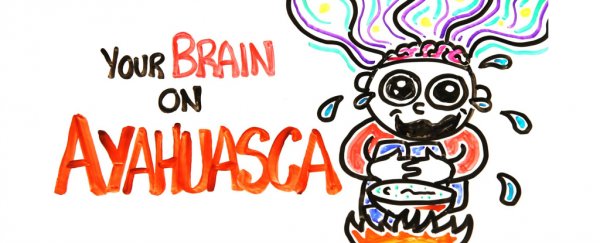
For centuries, shamans in the Amazon rainforest have been using the hallucinogenic brew ayahuasca to help guide people through visual and auditory hallucinations, and now the drug is gaining popularity in the rest of the world, too, with early research suggesting that it might even help treat depression and anxiety.
But what exactly is ayahuasca? And how does a plant-based brew produce trips that can be as intense as LSD - along with infamously violent bouts of vomiting?
The latest episode of AsapSCIENCE explains that it's all thanks to some powerful natural compounds delivered in just the right mix.
In fact, although most people think ayahuasca is a single plant, it's actually a combination of two plants - the leaves of Psychotria viridis and the vines of Banisteriopsis caapi.
Neither of them have hallucinogenic power on their own, but the leaves are known to contain DMT - a chemical that's structurally similar to the neurotransmitter serotonin, and is also structually similar to the compound found in magic mushrooms, which has shown similar potential in treating depression.
Our gut enzymes normally deactivate DMT so it doesn't affect us, but the vines in ayahuasca somehow inhibit these enzymes from working properly and allow DMT to enter your bloodstream and eventually cross the blood-brain barrier - which is where the fun really begins.
Within around half an hour of consumption, the drink starts to take effect, with hallucinations peaking after 1 hour, and usually wearing off by around 6 hours.
But what's interesting about these hallucinations is that, unlike the trips produced by LSD and 'shrooms, people on ayahuasca are much more aware that they're hallucinating and generally alert.
And instead of hearing voices, what they hear are just exasperations of the sounds occurring around them - which is why shamans often play music during the ayahuasca ceremonies.
After the experience, many people report being more at ease with their thoughts, and are more accepting of their present situation. Rather than simply getting high, most people take ayahuasca to reconcile past experiences and emotions and find inner peace.
So what's going on in our brains when we're on ayahuasca to produce such unique and strange side effects?
We still don't know enough about the drug to say for sure, but as AsapSCIENCE explains, we do know that it seems to quieten a region of the brain known as the default mode network, which, when overactive, is linked to depression, anxiety, and social phobia.
It's the same effect produced by meditation. There's also some evidence that DMT could help promote long-term memory and the growth of new neurons - and it might even have the potential to kill certain cancer cells.
That's not to say ayahuasca could be used to treat cancer in its current form, but scientists suspect there might be some useful properties of the brew that could be used to fight cancer in the future.
Just like any drug, however, ayahuasca also has a dark side - including the aforementioned vomiting.
We'll let the AsapSCIENCE boys talk you through that in the video above, but just remember, the data available for hallucinogenic drugs are still extremely limited, so - good and bad - we're only just beginning to understand what they're capable of.
